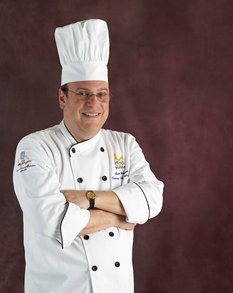50-Minute Classroom: Teaching Steaming
03 March 2013
 Steam is a very efficient method of cooking, but students approaching it for the first time tend to overlook several important considerations to ensuring food quality.
Steam is a very efficient method of cooking, but students approaching it for the first time tend to overlook several important considerations to ensuring food quality.
By Adam Weiner, CFSE
In January I wrote than, in my opinion, students need to have a good working knowledge of the following recipes and technique. In the past I have written articles about teaching braising (September 2010), baking (July 2011) and sautéing (January 2012) in 50 minutes. In the next several months (with an occasional break here and there to spice things up), I will write how to teach other basic cooking techniques.
This month, steaming.
1. What Is Steaming?
According to The New Food Lover’s Companion:
“Steam: Cooking method whereby food is placed on a rack or in a special steamer basket over boiling or simmering water in a covered pan. Steaming does a better job than boiling or poaching of retaining a food’s flavor, shape, texture and many of the nutrients.”
The key parts of the technique are:
a. The food is placed OVER (not in) the boiling or simmering water, and
b. The container is covered.
You need to stress these two items to your students. I strongly suspect that if you asked most of your students to prepare steamed cauliflower, they would place the cauliflower directly in the water.
2. Equipment
When you finally get the point across that the food needs to be placed on top of the liquid and the pan must be covered, most students will think of the bamboo steaming baskets they have seen on television and in the movies. However:
a. The steaming baskets you use probably shouldn’t be bamboo. First, many health departments don’t approve of bamboo steamers because they can’t be properly sanitized. Second, they need to be soaked for a long time before use to keep them from cooking themselves. Third, they tend to char. The smell of charring steamer baskets is—I assure you—not pretty. You have to trust me on this one.
b. Most restaurant-supply stores will have steaming baskets in stainless or aluminium. They either come with a designated pot or you add them on top of one of the pots you already have. Warped pans (i.e., pans that are not round) don’t work well for this purpose because the parts don’t fit together. It is critical that the lid fit tightly.
c. Most commercial kitchens (I would suspect many teaching kitchens) don’t have steaming racks at all, or if they do, certainly not enough steaming for everyone. No problem. Place your steaming liquid in a pot. Place a cup (like a soup cup or coffee cup) upside in the middle of the pot. Take a plate that is slightly smaller than the pot, put the food on top, and then place that on the inverted cup. The plate must be at least an inch below the top of the top. Cover tightly. Don’t have a tight-fitting lid? Wrap the top with foil or place a mixing bowl on top.
3. Season the Food
Remember that you will probably need to season the food before steaming. For some reason students tend to forget the basics (such as salt and pepper) when steaming.
4. Flavorful Liquid
Food Lover’s Companion refers to food being cooked over water. That’s fine if you don’t want to add any flavor, such as when you are steaming Asian pork buns. However, many steamed items can be improved by steaming over a flavorful liquid. For example, imagine eating a piece of salmon steamed over water versus a piece of salmon steamed over a combination of water, soy sauce, fresh minced ginger and lemon grass.
5. Placement of the Food
Put the food directly on the rack if you are steaming food (such as Asian dumplings) when you don’t need to retain the steaming liquid. If you want to serve the liquid from the food (such as with fish) then put the food on a plate and put the plate on the steamer rack.
6. Don’t Overdo It
Steam is a very efficient form of cooking. It will cook the food quickly. The only way for a new cook or student to know if something is done is to check it frequently.
7. Steam a Variety of Foods
Almost every type of food product can be steamed. However, there are a few general rules:
a. The less dense the food, the better it will steam. Fish steams better than beef.
b. Food of uniform size is better for steaming.
c. Food with a higher moisture content (such as vegetables) work better in a steamer than food with a very low moisture content (such as dried grains.)
Finally, one word of advice: Make sure you have good ventilation in your classroom (either from open windows and doors or front exhaust fans and hoods) before having groups of students practice steaming at the same time.
Chef Adam Weiner, CFSE, teaches a 20-week Introduction to Cooking program for JobTrain on the San Francisco Peninsula.
